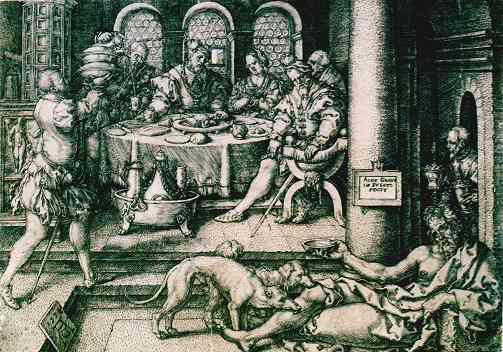Banquets
Music for such lavish* banquets at Court was provided by such courtly instruments as the recorders and viols. Click for more on these instruments.
Dramatic entertainment was provided in the form of an "interlude" or short debate on some topic of general interest--such as whether a pardoner, a palmer, an apothecary, or a pedlar were the greatest liar. Click for more.
Shakespeare sometimes uses the image of a disorderly banquet to illustrate disorder on a larger scale. Go to the section where banquets in Macbeth and The Tempest are discussed.
A menu* and some recipes* for a banquet are described by Gervase Markham in The English Housewife (1615).
Footnotes
-
Rich and poor
The need for Christian charity to the poor is underlined in the parable of Dives and Lazarus (Luke 16: 19-31). The poor Lazarus is graphically drawn with dogs licking his sores as the rich feast in comfort.
-
A compound salad
(As distinct from "simple"-- a compound salad was composed of many ingredients.)
"To compound an excellent salad, and which indeed is usual at great feasts, and upon princes' tables: take a good quantity of blanched almonds, and with your shredding knife cut them grossly; then take as many raisins of the sun, clean washed and the stones picked out, as many figs shred like the almonds, as many capers, twice so many olives, and as many currants as of all the rest, clean washed, a good handful of the small tender leaves of red sage and spinach; mix all these well together with good store of sugar, and lay them in the bottom of a great dish; then put unto them vinegar and oil, and scrape more sugar over all.
"Then take oranges and lemons, and, paring away the outward peels, cut them into thin slices, then with those slices cover the sallat all over; which done, take the fine thin leaf of the red cauliflower, and with them cover the oranges and lemons all over; then over those red leaves lay another course [layer] of old olives, and the slices of well pickled cucumbers, together with the very inward heart of your cabbage lettuce cut into slices; then adorn the sides of the dish, and the top of the sallat with more slices of lemons and oranges, and so serve it up."Particularly noteworthy in this recipe is the number of ingredients which must have been imported: almonds, raisins, figs, capers, olives, currants, sugar, oranges and lemons.
The "cauliflower" mentioned in this recipe is probably a red broccoli; its presence in this recipe is to be explained by its rarity:
"Cauliflowers are to be had in this country but very seldom, for that it is hard to meet with good seed."
